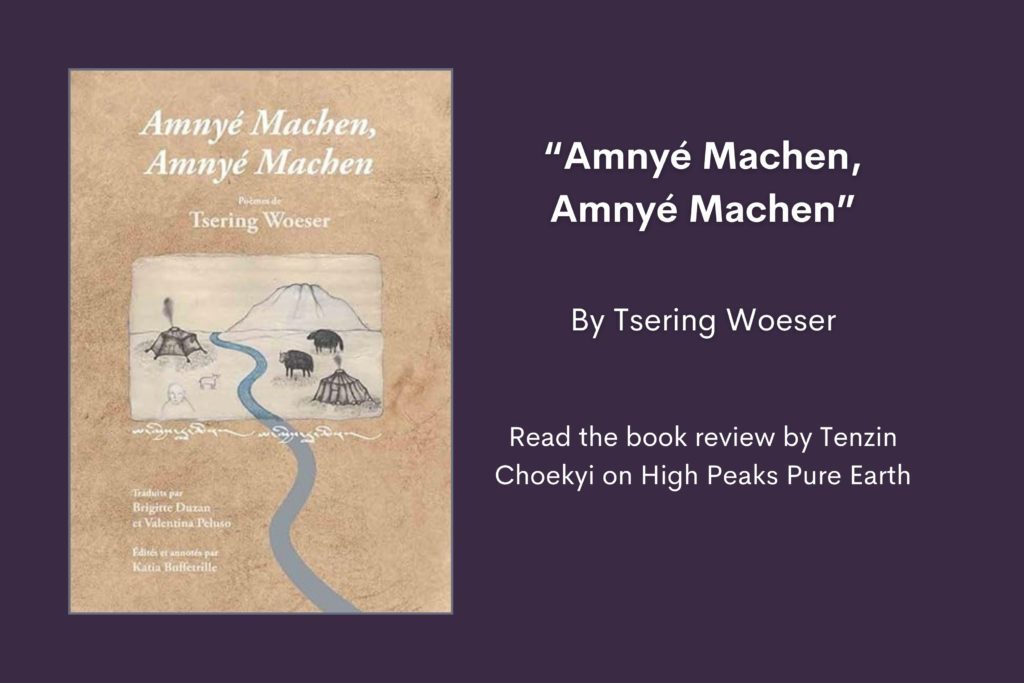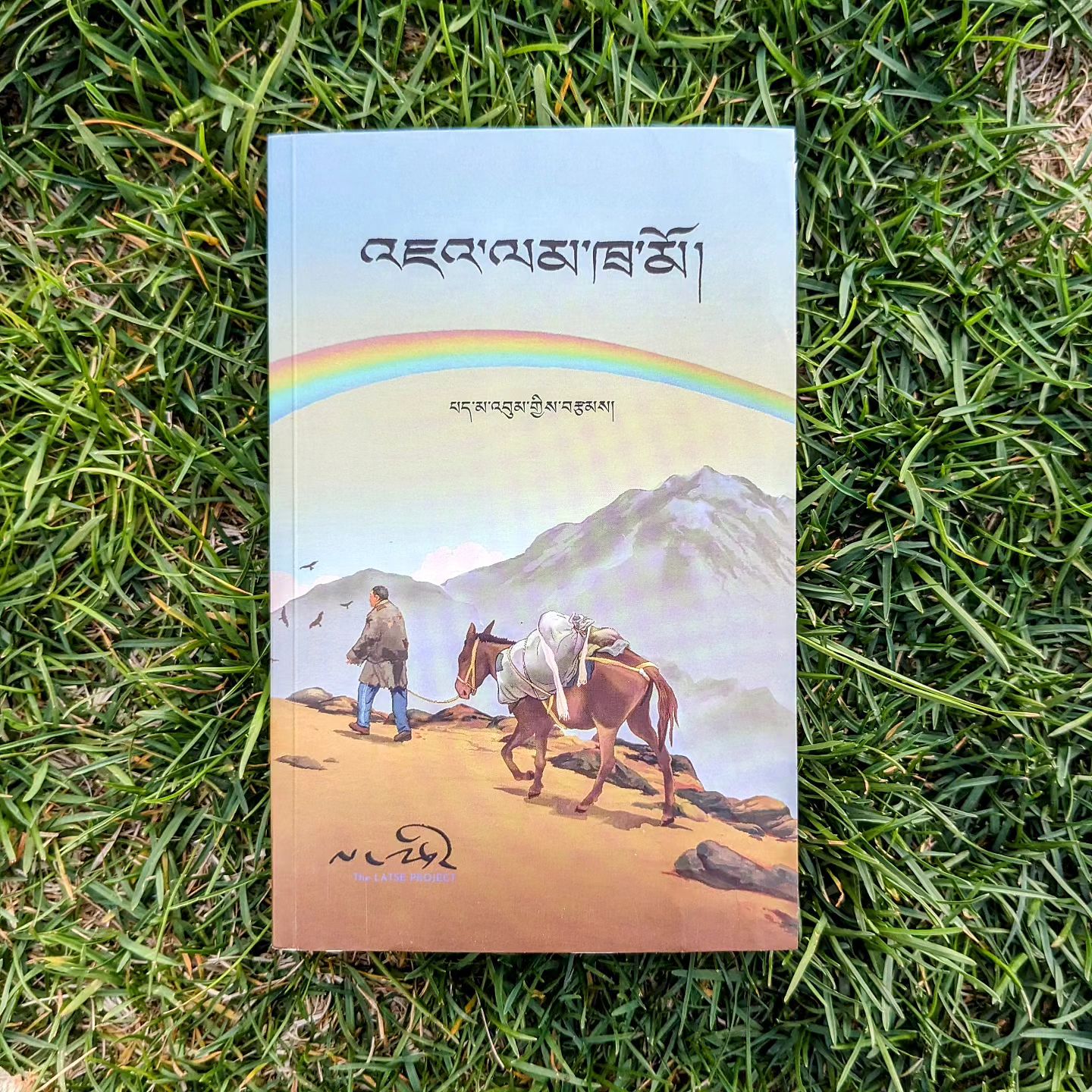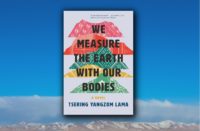High Peaks Pure Earth presents Tenzin Choekyi’s* review of “Amnyé Machen, Amnyé Machen” by Tsering Woeser. “Amnyé Machen, Amnyé Machen” was published in August 2023 by Editions Jentayu and is comprised of 83 narrative poems by Tsering Woeser in French translation.
The poems were translated by Brigitte Duzan and Valentina Peluso. Tibet scholar Katia Buffetrille edited and annotated the text. The poems were composed during a pilgrimage to Amnyé Machen in 2018. Read a piece in Global Voices interviewing those involved in this book project here.
“Amnyé Machen, Amnyé Machen” featured recently in the High Peaks Pure Earth Winter 2023 Tibet Reading List. Our heartfelt thanks to Tenzin Choekyi for this book review!

“Amnyé Machen, Amnyé Machen” By Tsering Woeser:
Book Review by Tenzin Choekyi
In August 2018, the Tibetan poet and writer Tsering Woeser, who is constantly under the watch of eagles and dogs – nicknames Tibetans inside Tibet use for Chinese police – sets off on her first pilgrimage to the sacred snow-mountain range of Amnyé Machen in Golok, eastern Tibet. It was a trip she had been longing for, praying for. As her flight takes off from Xining, she was prepared with customary offerings from Lhasa: pine and cypress powder ground by the monks of Gaden monastery, rice and barley blessed by Jowo Rinpoche, a piece of yellow silk cut from the fabric that covered the Jowo’s shoulder, a white khata, and lastly, prayer flags for her beloved friend Elliot Sperling, an American historian of Tibet, who had unexpectedly passed away the year before.
Woeser is however not alone on that pilgrimage. She is with her long-time friend Katia Buffetrille, a French anthropologist, specialist of pilgrimage of Tibetan mountains, for whom the pilgrimage was her fourth. Born in Chamonix, in the foothills of Mont Blanc, Katia sees herself as a “daughter of the mountains”, and thinks often, to this day, of the nomads she met in Amnyé Machen on her first pilgrimage in 1990 – their open-heartedness and generosity – how they welcomed and fed her as one of their own.
Woeser and Katia set off on the pilgrimage together with Gogo, their local guide, a Golok man, and Kamra, Gogo’s horse, who is named after his brown mane.
On foot for eight days, the four begin their journey around Amnyé Machen, memories of which were published two year later in Taiwan: Amnyé Machen, Amnyé Machen, a narrative poetry of 83 short free-verse poems, which, for Woeser, is “a gift from the mountain-god Amnyé Machen”.
The book was written in Chinese and Jerôme Bouchaud, the founder of Paris-based Edition Jentayu, a French publishing house specialising in Asian literature, decided to have it translated into French after reading it. A rough translation was first written by Valentina Peluso, which Brigitte Duzan then took over and worked on with Katia through constant dialogue to reach a translation as close as possible to the Chinese original, rooted in Tibetan reality, and without pinyin transcription.
Five years after the pilgrimage, the book is translated and published in French with 105 color photographs – many dating back to 1990 – an extensive glossary, and a letter from Katia to Woeser, written at the peak of the COVID-19 pandemic which includes another letter from 1990 from Tsering – a young merchant who joined Katia on her first pilgrimage after meeting on a bus journey.
Amnyé Machen, Amnyé Machen, the book title pulsates in rhythm and meaning, invoking how this sacred snow mountain range is, simultaneously, the mountain-god himself – deity, protector of dharma of Bon and Buddhists, and hidden treasures – as well as the abode of the mountain-god.
With a photo of Amnyé Machen, the poems begin with a prayer to the mountain-god, who:
rides a white horse with a green mane in Ngawa becomes a snow lion with a green mane/ whom the Goloks believe first rode a wild yak/ but always with the same majesty/always inspiring the same respect./May you protect us!
Woeser offers three prostrations and places a white stone amid hundreds of others on a cairn to “receive the key to open the pilgrimage”. That moment of centering, of the body and the mind with the intention, collides, as she turns around, and sees an external reality of colonial intrusion; a white metal signboard displaying: Tiananmen Square in red paint, the Chinese national flag, and the slogans “ethnic unity” and “Chinese dream” written in Tibetan, and two times larger in Chinese.
Searching for memories, as always, she continues her pilgrimage with questions: “Pola, Mola, what did your ancestors, the Goloks, look like ? ”, “And you, who are you, to Amnyé Machen ?”, she asks Katia. The questions then unfold into the history of the Goloks, the people, who refuse to be called Amdowas and Khampas, and their land, where Amnyé Machen li(v)es.
Tracing to times of imperial Tibet when the first inhabitants of Golok, the Gyalrongpas, were dispatched to the borderlands, stories remembered by the present-day Goloks unravel – the people who lived, and perished in this land – and steadily reach closer to their lives, and sadder, as they walk up the mountain.
A century before, Gogo’s ancestors, an entire family hiding in a snow-mountain, were massacred during a violent ambush led by the Muslim warlord Ma Bufang. Amnyé Machen, in 1958, the year when the communist Chinese forcibly collectivised land in eastern Tibet and slaughtered the nomads’ livestock, they nearly left for India, finding the suffering unbearable to carry. And 2008, the year when freedom protests erupted across Tibet, Gogo’s father was locked up in prison for singing for his homeland and people. All this suffering has not seen an end since 1958 when, as Woeser writes:
In front of the armies’ tents, the Goloks still thought/the sky was theirs, the earth was theirs
She crosses a river on Kamra and sees alpine meadows dotted with flowers. Leaning forward, she scans them with an app to learn their names, and eventually the sky clears up when they reach a pass, Tamchok Gongka, where dozens of horse skulls lay – offerings by their riders to help their horses’ spirit pass through bardo. Kamra is unfazed, and Gogo, on seeing the agate-color of rocks, says that those were the unmistakable traces of snow long gone.
And there, at the Tamchok Gongka pass, as the clouds leave the sky, Woeser finds herself in tears. Prostrating nine times, she takes out her offerings from Lhasa, and puts up the prayer flags of which on one she wrote “Elliot Sperling”, and on another “to all those who perished from a violent death since 1950”:
As such are these two flags tied one to another / amid the mass of so many others / fluttering windward each of these words / towards the solemn face of Amnyé Machen.
Amnyé Machen, Amnyé Machen is also an elegy for the snows and glaciers of Tibet, which are melting like the Arctic and Antarctic, with temperatures rising faster than the global average. Woeser personifies the Chinese mining cranes and prospectors as the infernal horde of hungry ghosts, whose greed, insatiable – without stopping for the past ten years – have extracted copper from the foothills of Amnyé Machen, yet have blamed the melting on climate change.
The snowline is receding every year, Gogo mourns, foreseeing that nothing more than rocky peaks will be left by the time his children’s children become adults.
Pilgrims they meet on their path express anguish, disbelief from having seen snow and ice melt off from the mountain peaks wherever they had been. And so, Woeser asks what will become of the widely recited prayer for Tibet in future:
“The pure land encircled by snowy mountains”/Will it become “the pure land encircled by bare mountains?”
When she considers taking home some water from a glacial lake – a sacred relic – she remembers that the water level at Lake Namtso is falling, and the Machu River is drying up at its source.
The melting of the Third Pole has long been defined in scientific language but has, thus far, lacked intimate words that capture the melting, the mourning of people at its centre in Tibet. Every village and valley in Tibet have a version of this grief, and in Amnyé Machen, Amnyé Machen what the melting creates and obliterates comes alive in grief through, perhaps, the most memorable imagery of loss; The picturesque chaos of blocks of ice formed and disappeared by the melting is seen:
Like thousands of tents of the nomadic people/Or even better, dozens of hands joined in prayer
Loss is inherent and contrapuntal in this comparison. Not only is the loss seen in forms symbolic of Tibetan culture and religion, but the comparison for loss, too, is contrapuntal to how the Tibetan culture and religion have been and are being made lost under Chinese colonial policies, evoking thus, at once, the systematic depopulation of Tibetan nomads off their ancestral grasslands, and the monks and nuns from monastic institutions.
When Loden, a friend who takes them on a car journey around Amnyé Machen for their second pilgrimage, makes the comparison, he adds that there are too many [Chinese] tourists, who Woeser would later observe trample upon prayer flags, exclaim loudly without respect to the silence in the sacred mountains, and take photographs.
Placing antonyms in direct collision against, or march one after the other, her poems later accumulate a rhythm of rigidity as she reflects on domestication forced upon the Tibetans under China’s colonisation, and how its process, the (a)symmetry of control, has not left the Tibetan land, its people, and animals unscathed; fence: thick or thin, shiny or rusty, Yaks: individual or collective domestication, closed or selective breeding, and Tibetan: to lose one’s language but not heart, or to lose one’s heart but not language.
Towards the end of her pilgrimage, Loden echoes what Woeser had been told earlier:
No longer will the snow mountain exist, his spirit will be lost/People will have money, but desperately empty hearts
The future that the Goloks foresee as being inexorable reinforces in grief at the end of her pilgrimage when Woeser is, once again, transported to the past upon meeting Chadrel Choying Rinpoché, who has not once uttered a word since the unimaginable bloodshed of 1958. Woeser thinks to herself that he could be an incarnation of Amnyé Machen in this world, a Boddhisatva, and as he sits quietly in the rain, she offers three prostrations at his feet.
On the eve of her departure, she meets a fortune-teller whose divination brings courage to her heart, a heart bridled by uncountable terrors.
Five years later, despite remaining under the watch of eagles and dogs, she sent a video message for the book launch in Paris, expressing hope – hope that the sacred mountains always remain, for all sentient beings, and for their happiness.
In my mind, after reading Amnyé Machen, Amnyé Machen a memory I had lost access to for over two decades returned. I am a toddler, standing under a deodar tree in the mountains, and crying from fear that my father might fall as he climbs up the tree higher to collect sang – offerings for the sacred mountains of Tibet, from exile. It is the first time I am remembering – the first sang collection I can remember. And even after falling off a steep mountain slope and being scolded to never climb up the mountain again alone, I would grow up longing for snow each winter, and climb up a mountain with fluttering prayer flags to bury my grandmother’s ashes under the snow and keep some to return in the barley fields in Tibet, where she once played, happily, with the bird nests.
–
*Tenzin Choekyi is Senior Researcher at Tibet Watch and provides analysis of the situation inside Tibet to parliamentarians, journalists and campaigners. A trilingual interpreter with a specialisation in environmental science, she has previously served as a translator for Tibetan nuns and asylum seekers and worked with International Campaign for Tibet on UNESCO’s controversial nomination of Tsongon Achen Gangyab (Ch: Qinghai Hoh Xil).
The verses mentioned in the review were translated by Tenzin Choekyi from the French translation of the book.




Follow Us!